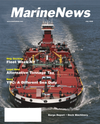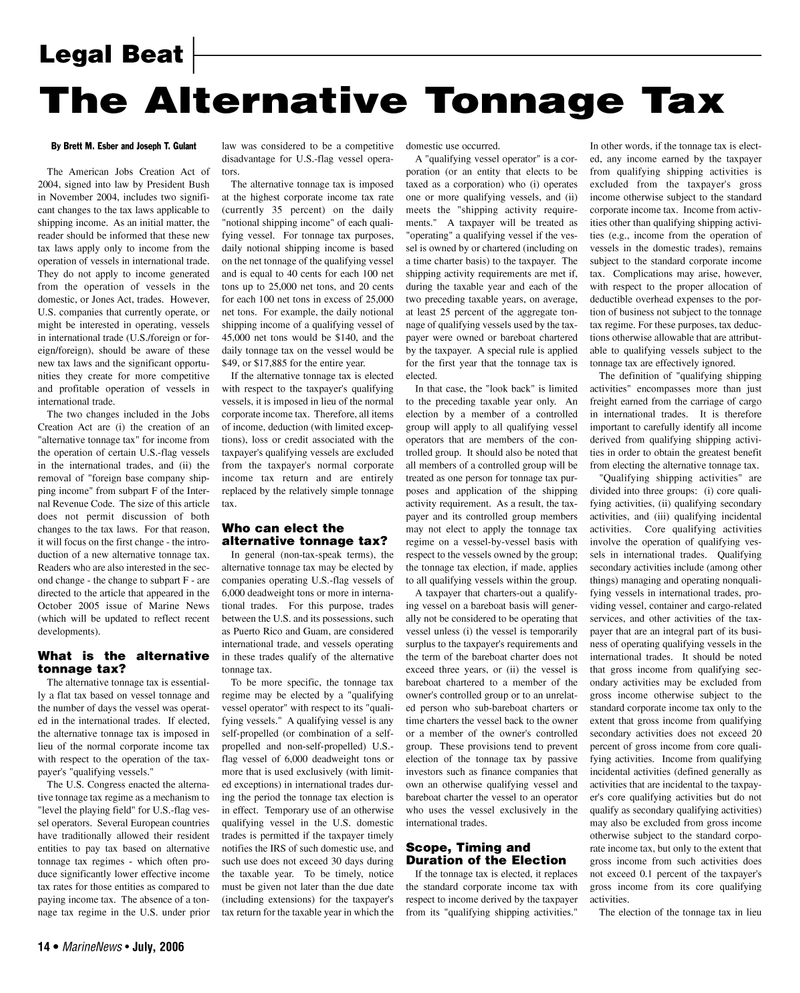
Page 14: of Maritime Reporter Magazine (July 2006)
The Satellite Communication Edition
Read this page in Pdf, Flash or Html5 edition of July 2006 Maritime Reporter Magazine
By Brett M. Esber and Joseph T. Gulant
The American Jobs Creation Act of 2004, signed into law by President Bush in November 2004, includes two signifi- cant changes to the tax laws applicable to shipping income. As an initial matter, the reader should be informed that these new tax laws apply only to income from the operation of vessels in international trade.
They do not apply to income generated from the operation of vessels in the domestic, or Jones Act, trades. However,
U.S. companies that currently operate, or might be interested in operating, vessels in international trade (U.S./foreign or for- eign/foreign), should be aware of these new tax laws and the significant opportu- nities they create for more competitive and profitable operation of vessels in international trade.
The two changes included in the Jobs
Creation Act are (i) the creation of an "alternative tonnage tax" for income from the operation of certain U.S.-flag vessels in the international trades, and (ii) the removal of "foreign base company ship- ping income" from subpart F of the Inter- nal Revenue Code. The size of this article does not permit discussion of both changes to the tax laws. For that reason, it will focus on the first change - the intro- duction of a new alternative tonnage tax.
Readers who are also interested in the sec- ond change - the change to subpart F - are directed to the article that appeared in the
October 2005 issue of Marine News (which will be updated to reflect recent developments).
What is the alternative tonnage tax?
The alternative tonnage tax is essential- ly a flat tax based on vessel tonnage and the number of days the vessel was operat- ed in the international trades. If elected, the alternative tonnage tax is imposed in lieu of the normal corporate income tax with respect to the operation of the tax- payer's "qualifying vessels."
The U.S. Congress enacted the alterna- tive tonnage tax regime as a mechanism to "level the playing field" for U.S.-flag ves- sel operators. Several European countries have traditionally allowed their resident entities to pay tax based on alternative tonnage tax regimes - which often pro- duce significantly lower effective income tax rates for those entities as compared to paying income tax. The absence of a ton- nage tax regime in the U.S. under prior law was considered to be a competitive disadvantage for U.S.-flag vessel opera- tors.
The alternative tonnage tax is imposed at the highest corporate income tax rate (currently 35 percent) on the daily "notional shipping income" of each quali- fying vessel. For tonnage tax purposes, daily notional shipping income is based on the net tonnage of the qualifying vessel and is equal to 40 cents for each 100 net tons up to 25,000 net tons, and 20 cents for each 100 net tons in excess of 25,000 net tons. For example, the daily notional shipping income of a qualifying vessel of 45,000 net tons would be $140, and the daily tonnage tax on the vessel would be $49, or $17,885 for the entire year.
If the alternative tonnage tax is elected with respect to the taxpayer's qualifying vessels, it is imposed in lieu of the normal corporate income tax. Therefore, all items of income, deduction (with limited excep- tions), loss or credit associated with the taxpayer's qualifying vessels are excluded from the taxpayer's normal corporate income tax return and are entirely replaced by the relatively simple tonnage tax.
Who can elect the alternative tonnage tax?
In general (non-tax-speak terms), the alternative tonnage tax may be elected by companies operating U.S.-flag vessels of 6,000 deadweight tons or more in interna- tional trades. For this purpose, trades between the U.S. and its possessions, such as Puerto Rico and Guam, are considered international trade, and vessels operating in these trades qualify of the alternative tonnage tax.
To be more specific, the tonnage tax regime may be elected by a "qualifying vessel operator" with respect to its "quali- fying vessels." A qualifying vessel is any self-propelled (or combination of a self- propelled and non-self-propelled) U.S.- flag vessel of 6,000 deadweight tons or more that is used exclusively (with limit- ed exceptions) in international trades dur- ing the period the tonnage tax election is in effect. Temporary use of an otherwise qualifying vessel in the U.S. domestic trades is permitted if the taxpayer timely notifies the IRS of such domestic use, and such use does not exceed 30 days during the taxable year. To be timely, notice must be given not later than the due date (including extensions) for the taxpayer's tax return for the taxable year in which the domestic use occurred.
A "qualifying vessel operator" is a cor- poration (or an entity that elects to be taxed as a corporation) who (i) operates one or more qualifying vessels, and (ii) meets the "shipping activity require- ments." A taxpayer will be treated as "operating" a qualifying vessel if the ves- sel is owned by or chartered (including on a time charter basis) to the taxpayer. The shipping activity requirements are met if, during the taxable year and each of the two preceding taxable years, on average, at least 25 percent of the aggregate ton- nage of qualifying vessels used by the tax- payer were owned or bareboat chartered by the taxpayer. A special rule is applied for the first year that the tonnage tax is elected.
In that case, the "look back" is limited to the preceding taxable year only. An election by a member of a controlled group will apply to all qualifying vessel operators that are members of the con- trolled group. It should also be noted that all members of a controlled group will be treated as one person for tonnage tax pur- poses and application of the shipping activity requirement. As a result, the tax- payer and its controlled group members may not elect to apply the tonnage tax regime on a vessel-by-vessel basis with respect to the vessels owned by the group; the tonnage tax election, if made, applies to all qualifying vessels within the group.
A taxpayer that charters-out a qualify- ing vessel on a bareboat basis will gener- ally not be considered to be operating that vessel unless (i) the vessel is temporarily surplus to the taxpayer's requirements and the term of the bareboat charter does not exceed three years, or (ii) the vessel is bareboat chartered to a member of the owner's controlled group or to an unrelat- ed person who sub-bareboat charters or time charters the vessel back to the owner or a member of the owner's controlled group. These provisions tend to prevent election of the tonnage tax by passive investors such as finance companies that own an otherwise qualifying vessel and bareboat charter the vessel to an operator who uses the vessel exclusively in the international trades.
Scope, Timing and
Duration of the Election
If the tonnage tax is elected, it replaces the standard corporate income tax with respect to income derived by the taxpayer from its "qualifying shipping activities."
In other words, if the tonnage tax is elect- ed, any income earned by the taxpayer from qualifying shipping activities is excluded from the taxpayer's gross income otherwise subject to the standard corporate income tax. Income from activ- ities other than qualifying shipping activi- ties (e.g., income from the operation of vessels in the domestic trades), remains subject to the standard corporate income tax. Complications may arise, however, with respect to the proper allocation of deductible overhead expenses to the por- tion of business not subject to the tonnage tax regime. For these purposes, tax deduc- tions otherwise allowable that are attribut- able to qualifying vessels subject to the tonnage tax are effectively ignored.
The definition of "qualifying shipping activities" encompasses more than just freight earned from the carriage of cargo in international trades. It is therefore important to carefully identify all income derived from qualifying shipping activi- ties in order to obtain the greatest benefit from electing the alternative tonnage tax. "Qualifying shipping activities" are divided into three groups: (i) core quali- fying activities, (ii) qualifying secondary activities, and (iii) qualifying incidental activities. Core qualifying activities involve the operation of qualifying ves- sels in international trades. Qualifying secondary activities include (among other things) managing and operating nonquali- fying vessels in international trades, pro- viding vessel, container and cargo-related services, and other activities of the tax- payer that are an integral part of its busi- ness of operating qualifying vessels in the international trades. It should be noted that gross income from qualifying sec- ondary activities may be excluded from gross income otherwise subject to the standard corporate income tax only to the extent that gross income from qualifying secondary activities does not exceed 20 percent of gross income from core quali- fying activities. Income from qualifying incidental activities (defined generally as activities that are incidental to the taxpay- er's core qualifying activities but do not qualify as secondary qualifying activities) may also be excluded from gross income otherwise subject to the standard corpo- rate income tax, but only to the extent that gross income from such activities does not exceed 0.1 percent of the taxpayer's gross income from its core qualifying activities.
The election of the tonnage tax in lieu 14 • MarineNews • July, 2006
Legal Beat
The Alternative Tonnage Tax
JULY MN2006 2(9-16).qxd 7/6/2006 11:25 AM Page 14

 13
13

 15
15
